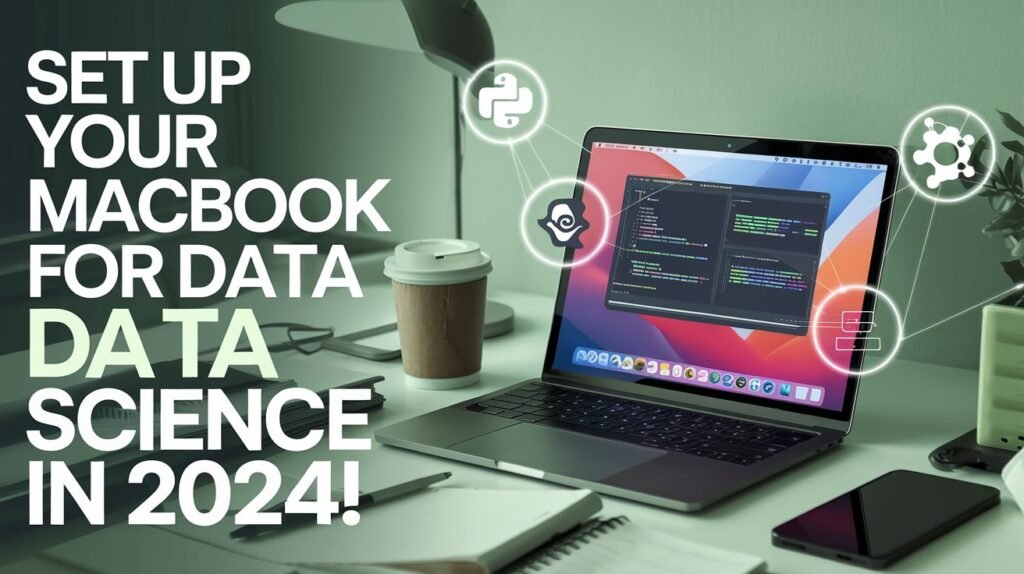Data science continues to be one of the fastest-growing fields in technology, and MacBook users are increasingly becoming the go-to choice for many data scientists. With its robust ecosystem, powerful hardware, and intuitive operating system, macOS offers a strong foundation for developing data science skills. If you’re looking to set up your MacBook for data science in 2024, this guide will walk you through everything from necessary software installations to hardware optimizations.
1. Assess Your MacBook’s Specifications
Before diving into the setup process, it’s essential to assess your MacBook’s hardware capabilities. Data science tasks can be resource-intensive, so ensure your device meets the following recommended specifications:
- Processor: At least an Apple M1 chip or Intel Core i5 or better.
- RAM: 16 GB is optimal for handling large datasets and running multiple applications.
- Storage: A solid-state drive (SSD) with at least 512 GB of space is recommended for speed and performance.
- OS: macOS Monterey (12) or later.
To check these specifications, click the Apple logo in the top left corner of the screen, and select About This Mac.
2. Update Your macOS
Keeping your operating system up-to-date is crucial for performance, security, and compatibility with the latest applications and libraries.
How to Update
- Open System Preferences and click on Software Update.
- Click on Update Now if updates are available.
- Follow the prompts to complete the installation.
Regular updates ensure that your MacBook runs smoothly and can efficiently handle data science tasks.
3. Install Homebrew
Homebrew is a powerful package manager for macOS that simplifies installing software. It’s a must-have for data scientists as it helps manage libraries and tools effectively.
How to Install Homebrew
- Open Terminal (you can find it in Applications > Utilities).
- Paste the following command:
/bin/bash -c "$(curl -fsSL https://raw.githubusercontent.com/Homebrew/install/HEAD/install.sh)"- Press Enter and follow the on-screen instructions.
After installation, you can use Homebrew to install various data science tools with a single command.

4. Install Python and Conda
Python is the most widely used programming language in data science due to its versatility and extensive libraries. You can install Python using Homebrew or Anaconda, which simplifies package management and deployment.
How to Install Anaconda
- Download the latest version of Anaconda from the official website.
- Follow the installation instructions.
Anaconda comes with Conda, a package manager that helps you create isolated environments and manage dependencies easily.
Create a New Environment
To create a new Conda environment for your data science projects, use the following command in Terminal:
conda create --name data_science python=3.10Activate the environment by running:
conda activate data_science5. Install Essential Libraries
Once you have your Python environment set up, it’s time to install essential libraries for data science.
Using pip or conda
You can install popular libraries such as NumPy, Pandas, and Matplotlib using either pip or conda. Here’s how to do it using conda:
conda install numpy pandas matplotlib scikit-learn seaborn jupyterThese libraries will form the backbone of your data science projects, facilitating data manipulation, analysis, and visualization.
6. Set Up Jupyter Notebooks
Jupyter Notebooks are an invaluable tool for data scientists, allowing for interactive coding and visualization.
How to Set Up Jupyter Notebooks
After installing Jupyter using the previous step, you can launch it using:
jupyter notebookThis command will open Jupyter in your default web browser. You can create new notebooks and start coding immediately!
7. Install Additional Data Science Tools
To further enhance your data science workflow, consider installing the following tools:
a. R and RStudio
R is another programming language widely used in data science, particularly for statistical analysis. RStudio is a powerful integrated development environment (IDE) for R.
Install R:
- Download R from the CRAN website.
- After installing R, download RStudio from the RStudio website.
b. Tableau or Power BI
For data visualization and reporting, tools like Tableau or Microsoft Power BI can be invaluable.
Get Tableau:
- Visit the Tableau website and download the free trial or educational version.
Get Power BI:
Unfortunately, Power BI is not natively available on macOS; however, you can use it through a virtual machine or access it via the web using Power BI online.
8. Version Control with Git
Git is essential for managing changes in code and collaborating with others. Setting up Git on your MacBook is straightforward.
How to Install Git
You can use Homebrew to install Git:
brew install gitConfigure Git
After installation, configure your Git username and email:
git config --global user.name "Your Name"
git config --global user.email "you@example.com"Create a GitHub Account
Don’t forget to create an account on GitHub to store your repositories and collaborate with others.
9. Set Up an Integrated Development Environment (IDE)
While Jupyter Notebooks are excellent for exploratory work, setting up a full-fledged IDE can greatly improve your productivity and coding experience.
a. Visual Studio Code
Install Visual Studio Code:
- Visit the VS Code website and download the latest version.
- Once installed, you can add extensions such as Python and Jupyter to enhance functionality.
b. PyCharm
PyCharm is another great Python development option.
Install PyCharm:
- Download PyCharm from the JetBrains website.
- Choose between the free Community version or the paid Professional version.
10. Utilize Cloud Services for Scalability
As your data science projects grow, you may need more processing power than your MacBook can provide. Utilizing cloud services can help you scale your computations.
Top Cloud Providers
- AWS (Amazon Web Services)
- Google Cloud Platform
- Microsoft Azure
What to Set Up
- Consider using cloud-based Jupyter Notebooks through Google Colab for free, scalable resources.
- For larger datasets and projects, look into setting up virtual machines on AWS or GCP.
11. Keep Learning and Networking
The field of data science is constantly evolving, and staying updated is crucial. Here are a few resources and platforms where you can continue learning:
Online Courses
- Coursera: Offers a wide range of data science courses from recognized institutions.
- edX: Another great platform for acquiring new skills and certifications.
- Kaggle: Use Kaggle for hands-on practice through competitions and datasets.
Networking Opportunities
Join local or online data science communities. Websites like Meetup can help you find groups, while platforms like LinkedIn can be excellent for professional networking.
12. Ensure Security and Backup
As you dive into data science, it’s crucial to keep your data secure and backed up. Consider setting up the following:
a. Regular Backups
Enable Time Machine on your MacBook for automatic backups:
- Connect an external drive.
- Go to System Preferences > Time Machine.
- Select your backup disk and choose Backup Automatically.
b. Use Strong Passwords and 2FA
Implement strong, unique passwords for your accounts and enable two-factor authentication (2FA) for added security. Services like LastPass can help you manage your passwords easily.

Conclusion
Setting up your MacBook for data science in 2024 can be a straightforward yet powerful process. By carefully selecting the right tools, libraries, and resources, you can build a robust environment to support your data science journey. Whether you’re just starting or looking to deepen your expertise, the right setup will help you tackle projects confidently and efficiently.
Explore Further
To stay updated on the latest trends in data science, consider visiting resources like KDnuggets and Towards Data Science. Embrace the exciting world of data science and happy coding!
ALSO READ



